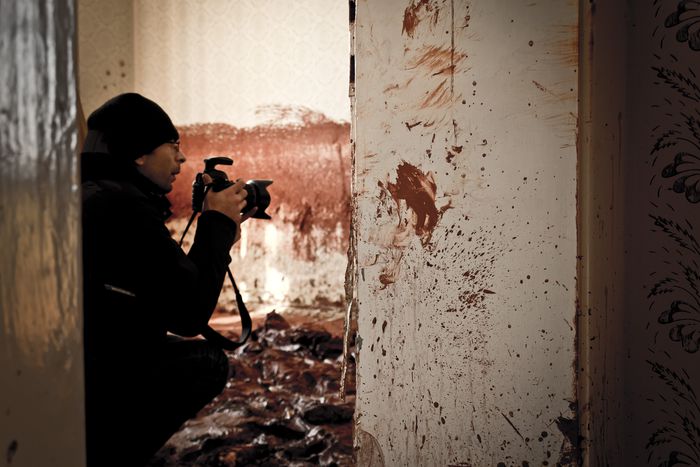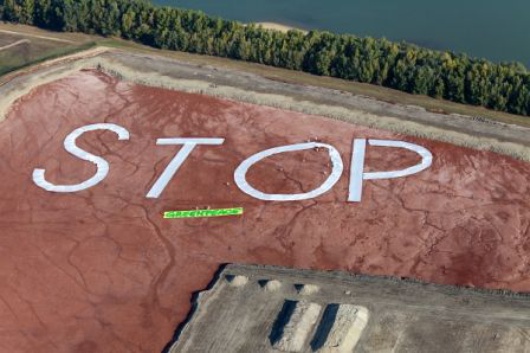
1 year on, Red sludge still a threat
Published on
Greenpeace: the reservoir of Almásfüzitő leaks More than one year had passed since the red sludge catastrophe in Kolontár. On the 4th of October 2010 the dike of the red sludge reservoir between Kolontár and Ajka ruptured and more than half a million cubic metres of toxic waste spread across the area.
The highly alkaline, corrosive liquid caused serious damages in three villages: Kolontár, Devecser and Somlóvásárhely. Since then new houses have been built but the environment is still not recovered from the contamination. The media and certain NGOs started to deal with the case of the red sludge reservoir of Almásfüzitő and the risks it poses after the tragedy in Ajka. We asked Gergely Simon the chemicals expert of Greenpeace Hungary about the problems and dangers of the reservoir.
Cafebabel: First we should talk about what happened in Kolontár. What has changed over the last year? Is the red sludge completely transferred?
Gergely Simon: The contamination is mostly removed. Few months ago when Greenpeace carried out measurements there, we found some the toxic metals in the soil which can be the consequence of the red sludge contamination, but they were below the threshold limit value. The current problem is that the factory lets out the liquid that used to be on top of the reservoir. Although it is neutralized, its salt content is still high. Furthermore its molybdenum content is also very high and every now and then it contains other toxic materials too. The problem is that instead of obliging them to pay an indemnity, the authorities raise the threshold limit values so that the recorded values can not be regarded as contamination. It is not good either when the contaminating material is let out on occasional permissions, nor is it better when cement is mixed with the red sludge, mainly because it is a bit inexperienced method and threatens to pose more risks. On the whole, we can say that the cleaning of the area has been carried out properly but the spending of the 15 billion Hungarian Forints meant to cover the restoration raises another issue. Even the Members of the Parliament would like to know that in detail.
CB: When has Greenpeace started to pay attention to these events? Have you kept an eye on this area before the catastrophe?
G. S.: Greenpeace started to deal with the catastrophe stricken area only after the tragedy. But other Hungarian NGOs, such as Levegő Munkacsoport (Clean Air Action Group) have been dealing with it before. They pointed out many times that the 30-40 million tons of red sludge is a very hazardous and actions should be taken against it because sooner or later it will lead to big problems. As we can see, unfortunately the experts of the organization were right.
CB: The tragedy drew attention to the red sludge reservoir in Almásfüzitő. Greenpeace also noticed this problem. Could you explain what the problem is with this reservoir?
G. S.: It was obvious that this dike usually leaked here and there. Traces of the leaking can be seen on some satellite pictures taken in 2007 and 2008. Records of TV channels shooting there also showed evidence of the leakage. Since then it has been resolved but Greenpeace asked international experts to examine what the biggest risk factors are in Hungary. Many of them came to the conclusion that Almásfüzitő is probably the most risky area in Hungary because 10-12 tons of red sludge is stored right next to the Danube, and other materials made of waste are piled upon this huge quantity. This waste placing is called composting (formerly experiment) by them. So waste is mixed in various ways (formerly with red sludge, now with each other) and they put it on top of the reservoir. The reservoir does not insulate properly. The contaminators of the red sludge get into the ground-water and can be found there in more than 100-200 times of the threshold limit. We found a contamination that could not came from the former alumina factory of Almásfüzitő, because contaminations were measured above human height. 166 different kinds of dangerous waste materials were placed on this leaking reservoir. They have permission to mix 412 thousand tons of dangerous and harmless materials and place there the product made of it. Since they had permission for 5 years, they could transfer 2 million tons of toxic mixture to this area.

CB: Is the weakening of the dike similar to that of Kolontár’s? Or is the leakage the main problem?
G. S.: We started to examine the leakage and its long term consequences, because we think this is the main problem. Experts have to examine how stable the dike is. I am a chemist and as such I can only give information about the chemical contamination. But there is no GPS or any other online monitoring system that would keep track of the movements of the dike. Zoltán Illés, Minister of State for Environmental Affairs said that the dike of the reservoir and the Danube can be in danger in case of an icy flood. It is worth to know that the corner that ruptured in Kolontár was the one that was built in a former river’s bed. The same goes for Almásfüzitő because the huge seventh reservoir was built in a former brook’s bed. That is why it is in the centre of our attention.
CB: There is an article on the webpage of Greenpeace Hungary about the organization turning to the prosecutorial office of Győr to start a lawsuit. Who do you think is responsible for this problem?
G. S.: With this act we did not mean to attack the inspectorate, we would like the prosecutorial office to start a procedure against the company on the grounds of environmental pollution an endangerment. It can be proved that they mix different kinds of waste and that the contamination gets out of the reservoir. We also protest against the permission issued by the inspectorate and we initiated an ombudsman investigation that has already been started. But now that ombudsman offices are merged we do not know what the result of this investigation will be. We think that the inspectorate authorized an impossible activity, namely the composting of materials that can not be composted. Composting means aerobic decomposing. There is an act on composting which lists the materials that can be composted. Inorganic materials that are the residues of metalcasting and metallurgy, and dangerous wastes contaminated with heavy metals are not among them. We think that the inspectorate authorized an absurd activity. The bank of the Danube is a Natura 2000 area and part of the EU bird and natural habitat saving program and ecological network and it is obligatory to investigate the effect on this, but they failed to do so. That is why we blame the inspectorate, but the petition we gave to the prosecutorial office was only intended to step up against the company.
CB: Has the prosecutorial office started the lawsuit?
G. S.: We received a letter from the prosecutorial office that the case was referred to the district prosecutorial office. The investigation of the jurisdiction is not finished, we do not know yet who should deal with it, so we do not know either how they will decide. One is for sure: we will not stop and we will look for other legal opportunities both nationally and internationally.
CB: We have talked about many topics, but you have not said yet what exactly Greenpeace wants. Do you want the company to transfer the waste or not to take there any more or maybe only to cover the reservoir and insulate it properly?
G. S.: The company should have covered the reservoir a long time ago to stop the dusting. If not covered red sludge creates dust while drying and since it contains irritating carcinogen materials it poses a serious health risk. It is unacceptable that after more than twenty years the reservoir is still uncovered. There are excellent methods to do this: they could cover it with a watertight layer or watertight foil. The most important thing is to cover the reservoir as soon as possible. It is the company’s and the inspectorate’s responsibility that they let this go on for 20 years while it could have been done in one year. It would be ideal if they stopped transferring more dangerous material to this leaking area. Hazardous materials should be measured thoroughly in this area, and all measures should be taken to reduce the contamination. Basically we would like dangerous wastes in Hungary to be handled according to the laws and guidelines of the European Union, because now they are treated with methods that are "alternative hungaricums".



